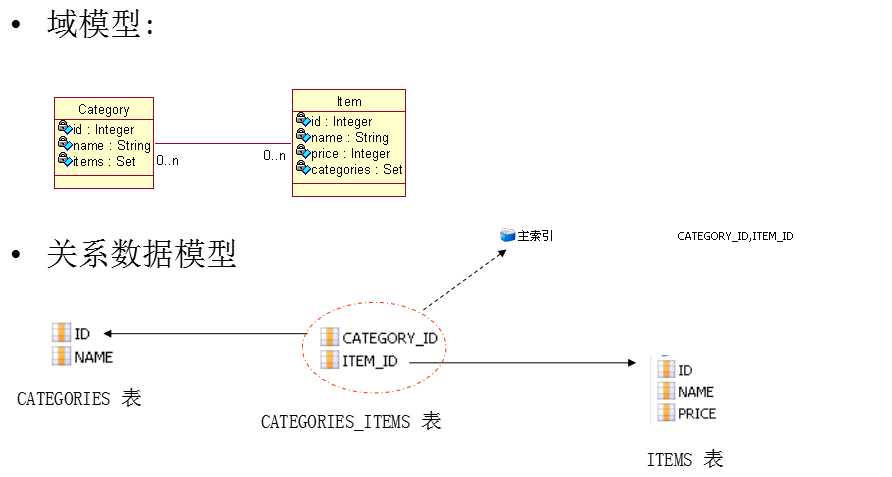标签:mit apply items 关联 实体类 logs class 关系 code
单向 n-n
n-n 的关联必须使用连接表
与 1-n 映射类似,必须为 set 集合元素添加 key 子元素,指定 CATEGORIES_ITEMS 表中参照 CATEGORIES 表的外键为 CATEGORIY_ID. 与 1-n 关联映射不同的是,建立 n-n 关联时, 集合中的元素使用 many-to-many. many-to-many 子元素的 class 属性指定 items 集合中存放的是 Item 对象, column 属性指定 CATEGORIES_ITEMS 表中参照 ITEMS 表的外键为 ITEM_ID

双向 n-n

双向 n-n 关联需要两端都使用集合属性
双向n-n关联必须使用连接表
集合属性应增加 key 子元素用以映射外键列, 集合元素里还应增加many-to-many子元素关联实体类
在双向 n-n 关联的两边都需指定连接表的表名及外键列的列名. 两个集合元素 set 的 table 元素的值必须指定,而且必须相同。set元素的两个子元素:key 和 many-to-many 都必须指定 column 属性,其中,key 和 many-to-many 分别指定本持久化类和关联类在连接表中的外键列名,因此两边的 key 与 many-to-many 的column属性交叉相同。也就是说,一边的set元素的key的 cloumn值为a,many-to-many 的 column 为b;则另一边的 set 元素的 key 的 column 值 b,many-to-many的 column 值为 a.
对于双向 n-n 关联, 必须把其中一端的 inverse 设置为 true, 否则两端都维护关联关系可能会造成主键冲突.
部分代码:
Category.java
private Integer id; private String name; private Set<Item> items = new HashSet<>();
Item.java
private Integer id; private String name; private Set<Category> categories = new HashSet<>();
Category.hbm.xml
<!-- table: 指定中间表 -->
<set name="items" table="CATEGORIES_ITEMS">
<key>
<column name="C_ID" />
</key>
<!-- 使用 many-to-many 指定多对多的关联关系. column 执行 Set 集合中的持久化类在中间表的外键列的名称 -->
<many-to-many class="Item" column="I_ID"></many-to-many>
</set>
Item.hbm.xml
<set name="categories" table="CATEGORIES_ITEMS" inverse="true">
<key column="I_ID"></key>
<many-to-many class="Category" column="C_ID"></many-to-many>
</set>
HibernateTest.java
public class HibernateTest { private SessionFactory sessionFactory; private Session session; private Transaction transaction; @Before public void init(){ Configuration configuration = new Configuration().configure(); ServiceRegistry serviceRegistry = new ServiceRegistryBuilder().applySettings(configuration.getProperties()) .buildServiceRegistry(); sessionFactory = configuration.buildSessionFactory(serviceRegistry); session = sessionFactory.openSession(); transaction = session.beginTransaction(); } @After public void destroy(){ transaction.commit(); session.close(); sessionFactory.close(); } @Test public void testGet(){ Category category = (Category) session.get(Category.class, 1); System.out.println(category.getName()); //需要连接中间表 Set<Item> items = category.getItems(); System.out.println(items.size()); } @Test public void testSave(){ Category category1 = new Category(); category1.setName("C-AA"); Category category2 = new Category(); category2.setName("C-BB"); Item item1 = new Item(); item1.setName("I-AA"); Item item2 = new Item(); item2.setName("I-BB"); //设定关联关系 category1.getItems().add(item1); category1.getItems().add(item2); category2.getItems().add(item1); category2.getItems().add(item2); item1.getCategories().add(category1); item1.getCategories().add(category2); item2.getCategories().add(category1); item2.getCategories().add(category2); //执行保存操作 session.save(category1); session.save(category2); session.save(item1); session.save(item2); } }
标签:mit apply items 关联 实体类 logs class 关系 code
原文地址:http://www.cnblogs.com/zhlzy/p/7231947.html